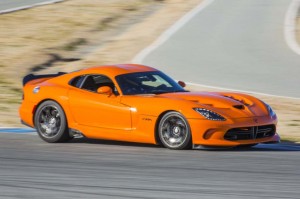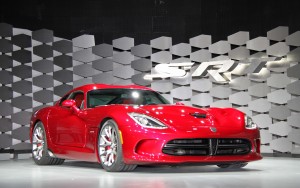Facing an unexpected slowdown in sales, Chrysler plans a one-third cut in production of its two-seat sports car, the SRT Viper.
Unveiled at the 2012 New York Auto Show and put on sale early this year, the $104,480 Viper was heralded as one of the best sports cars Detroit has ever produced – and more than capable of challenging European supercars costing twice as much.
But with the sports car segment seeing the launch of a wide range of new products – including the all-new 2014 Chevrolet Corvette – sales of the Viper have been running short of expectations. This year’s surge in fuel prices hasn’t helped, nor is the lack of winter tires for the 640-horsepower two-seater.
Largely built by hand at a small plant on the east side of Detroit, the SRT Viper returned to production this year after a brief absence that followed Chrysler’s 2009 bankruptcy and subsequent takeover by Fiat. There had been some speculation that the revived sports car would make extensive use of the Italian maker’s componentry – possibly borrowed from Italian brand Alfa Romeo – but, in the end, the Viper remained a very much American sports car with an emphasis on striking design brute and power.
(For more on the muscle car wars, Click Here.)
The SRT Viper is powered by a unique 8.4-liter V-10 engine pumping out 640 horsepower and 600 pound-feet of torque. It is, in fact, the highest torque output of any naturally aspirated engine in the world.
But despite initially solid reviews, sales haven’t lived up to expectations for the supercar, Chrysler originally forecasting sales of around 2,000 Vipers annually. Through September, however, the suburban Detroit-based maker had sold only 426 of the sports cars.
So, Chrysler now plans to reduce production by a third, from nine cars a day to just six — with affected workers being transferred to other jobs at the company. Even at that rate, it’s uncertain demand will keep pace with supply and the maker could yet order further cuts. Sales are expected to further decline over the winter. That’s normal in the sports car segment, especially for a model for which winter tires aren’t available.
(2014 Corvette customers face potential 6-month backlog. Click Here for details.)
Things got off to a bad start for the latest Viper program when production was pushed back from late 2012 until early this year. Chrysler had already scaled back expectations, previous Vipers selling at a rate of around 15 per day since the original, open-top roadster version was launched in 1992. Over the decades, Chrysler has sold more than 22,000 of the cars.
But the price has sharply creeped up, the new model topping the $100,000 mark for the first time. In fact, the 2014 Stingray, the seventh-generation Corvette, will start at around $52,000, or barely half the price of a Viper – albeit while making “only” 450 horsepower out of its V-8. An updated ZR1 version of the new Corvette is expected to follow in several years and is anticipated to be priced closer to the Viper.
Chrysler has been struggling to find ways to kick start sales of the SRT Viper and already offers a driving program for those who buy one of the supercars. But one problem is that dealers are reportedly reluctant to risk the cars they’ve got sitting on lots when potential buyers ask for a test drive. Reports indicate Chrysler now plans to offer dealers use of factory-owned cars to give customers a taste of what the Viper can do.


